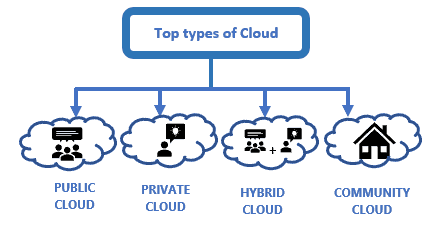1. Introduction
In this tutorial, we’ll discuss cloud security. We’ll talk about the types of cloud environments and how cloud security works. We’ll present the advantages, risks, challenges, and specific cloud security solutions.
2. Overview of Cloud Security
Cloud security is a set of protocols, technologies, and best practices for protecting cloud computing environments, data stored in the cloud, and applications running in the cloud. These measures ensure device and user authentication, data privacy protection, and data and resource access control.
Enterprises need cloud security as they implement digital transformation strategies and integrate cloud-based services and tools as part of their infrastructure.
Securing cloud services starts with understanding exactly what we need to protect and what aspects of the system we need to manage.
3. Types of Cloud Environments
When we’re looking for cloud-based security, we can choose between different main types of cloud environments. The top choices on the market include private cloud, public cloud, hybrid cloud, and community cloud:

It’s essential to understand how these environments differ from each other because each one has unique security advantages and disadvantages.
3.1. Public Cloud
A public cloud is a cloud environment generally developed by IT infrastructure that does not belong to the end user. Enterprises don’t need to set up anything to use the cloud because the provider manages everything.
In a public cloud, companies share access and on-premises to basic computing infrastructure (storage, servers, development platforms, networking) supplied by a cloud service provider (CSP). Typically, customers can access the provider’s web services through a web browser.
Security features such as identity management, access control, and authentication are critical to public clouds.
3.2. Private Cloud
Because we devote the computing infrastructure to a single client, private clouds have the distinct advantage of being able to offer better degrees of security and privacy. No longer must private clouds be sourced from on-premises IT infrastructure.
Since only one group has access to them, their isolation helps protect them from outside attacks. However, we must still deal with security risks like security breaches and social engineering.
3.3. Hybrid Cloud
In a hybrid cloud, we divide the deployment of an organization’s cloud into public and private cloud infrastructure. These clouds connect multiple environments, such as a public and private cloud, which can be more easily scaled as needed.
Organizations can use hybrid clouds to host their resource-intensive development platforms on the public cloud while safeguarding their sensitive data.
3.4. Community Cloud
Community clouds are a newer hybrid cloud variant designed to meet different companies’ specific needs. Community clouds offer more privacy and security than public clouds shared by multiple organizations.
It is challenging to establish service level agreements (SLAs) and manage security concerns when we share data and resources with other actors in Community clouds.
4. How Does Cloud Security Work?
Each cloud security measure is used to perform one or more of the following tasks:
- Allow data recovery in case of data loss
- Protect network and storage from malicious data theft
- Prevent data breaches caused by negligence or human error
- Reduce the impact of system or data compromise
In cloud security, we use complete security policies, a security-conscious company culture, and cloud security technologies to provide high-quality cloud data security.
However, there is no one explanation for how cloud security functions because it incorporates various tools and procedures. Making sure that only authorized users may access data stored in the cloud is the primary goal of cloud security.
5. Importance, Risks, and Challenges of Cloud Security
Because most firms now employ cloud computing in some capacity, cloud security is essential. Protecting data and business content, such as sales orders, secret design blueprints, and financial records is a crucial aspect of cloud security.
Maintaining customer trust and safeguarding assets that give us a competitive edge depend on preventing leaks and data theft. Cloud security is essential for every company moving to the cloud since it can safeguard our data and assets.
5.1. Risks of Cloud Security
Users and providers may be subject to a variety of cyber security risks due to the flaws in cloud security. Typical risks to cloud security include:
- Disruptions to third-party data storage services and incompatibility with traditional IT frameworks are among the risks associated with cloud-based infrastructure
- Internal dangers brought on by human error, including incorrectly configuring user access controls
- External dangers like phishing, malware, and DDoS attacks are virtually exclusively the work of evildoers
5.2. Challenges of Cloud Security
- Access Management. While an organization can successfully restrict and manage access points across on-premises systems, managing the same restrictions in a cloud environment can be challenging.
- Compliance. Managing compliance is often confusing for organizations using hybrid or public cloud deployments. Overall responsibility for data security and protection remains with the organization.
- Misconfigurations may include retaining the default administrator password or not creating suitable privacy.
- Lack of visibility. It’s easy to lose sight of how and who accesses our data. Since many cloud services have the possibility to access outside of corporate networks and through third parties.
6. Types of Cloud Security Solutions
The solutions encountered in cloud security are software that protects cloud infrastructure and identities, prevents threats, identifies and remediates vulnerabilities, and helps respond to incidents when they happen.
Cloud security solutions such as SAST (Static Application Security Testing), CASB (Cloud Access Security Brokers), SASE (Secure Access Service Edge), CWPP (Cloud Workload Protection Platforms), CSPM (Cloud Security Posture Management), and CIEM (Cloud Infrastructure Entitlement Management) help enhance visibility and automatically detect misconfigurations and vulnerabilities.
7. Conclusion
Thinking about cloud security is very important when we want to work in any cloud environment. The primary goal of cloud security is to ensure that only authorized users may access data stored in the cloud. Although all importance of cloud security, this one faces some challenges like compliance, misconfiguration, lack of visibility, and access management**.**